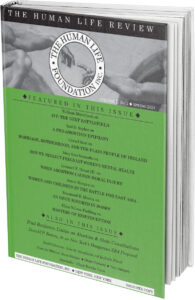TIME TO GIVE THE UNBORN THEIR DUE
This week the U.S. Supreme Court will hear oral arguments in Dobbs v. Jackson Women’s Health Organization. The case concerns Mississippi’s 2018 “Gestational Age Act,” which prohibits abortion after 15-weeks of gestation (13-weeks after fertilization). The question before the Court, however, concerns whether the state has the right to protect unborn babies at any stage prior to viability. Legal commentators, pundits, and pro-abortion groups all have opinions regarding what may happen—or what they hope may happen—in this case, but what is clear is that the abortion issue is far from settled.
At heart, the arguments for and against abortion are about rights: the “right” to take the life of an unborn child versus that child’s right to live and be welcomed at birth as a member of the human family.
The Court’s 1973 decisions in Roe v. Wade and Doe v. Bolton revolved around a “right to privacy,” which the justices located in “penumbras” of the Constitution. In 1992, the Court reworked its abortion-law framework in Planned Parenthood v. Casey, establishing an “undue burden” test that prevented legislation passed by a state from seriously impinging on a woman’s ability to obtain an abortion. But the Court did not clearly define what would create an “undue burden, and as a result, abortion laws continue to be disputed in the courts and legislatures.
Over the years, the justices have strongly adhered to stare decisis, that is, Supreme Court precedent, when deciding abortion cases. In 2020, in June Medical Services, LLC v. Russo, the Court nullified Louisiana’s “Unsafe Abortion Protection Act,” which had required doctors to have admitting privileges at a hospital within 30 miles of the clinic where they performed abortions. While comparisons were made to the Court’s 2016 decision in Whole Women’s Health v. Hellerstedt, which struck down a similar Texas law, there was a significant difference between the two laws: Louisiana’s was not unique to abortionists. The Louisiana state legislature had sought only to extend an already existing provision—one that was required of all other physicians in outpatient surgery settings—to abortionists. However, pro-abortion groups argued that implementation of the law would have resulted in the closing of all but one abortion clinic in the state, and the Court determined that this would create an “undue burden.”
While siding with the majority in June Medical, Chief Justice Roberts wrote a separate opinion in which he expounded on stare decisis:
The legal doctrine of stare decisis requires us, absent special circumstances, to treat like cases alike… Stare decisis (“to stand by things decided”) is the legal term for fidelity to precedent … This principle is grounded in a basic humility that recognizes today’s legal issues are often not so different from the questions of yesterday and that we are not the first ones to try to answer them.
But such adherence to stare decisis in the case now before the Court would ignore how much we have learned about the unborn child since Roe and Doe were decided, and how far prenatal medicine has advanced.
In 1973, perinatology and neonatology did not exist. In fact, the subspeciality of neonatology did not receive certification until 1975, and the Society of Perinatal Obstetricians for perinatologists (now called the Society for Maternal-Fetal Medicine) was not formed until 1977. Ultrasounds existed as early as the 1950s but were not yet in widespread use in maternal-fetal medicine. Today, ultrasound technology permits us to see the life of an unborn child in three dimensions. Doctors can now treat her as a separate patient from her mother, performing fetal surgery and administering other medical care.
By contrast, our laws concerning the humanity of the unborn remain fixed in the past. For example, in 1973, viability was set at 24-26 weeks of gestation. Today, due to technological advancement, premature babies born as early as 21-22 weeks are surviving. Viability is an unworkable standard in law because it is more of a reflection of advances made in medicine than it is of the development of the child herself. As Justice Sandra Day O’Connor noted in her 1983 dissent in Akron v. Akron Center for Reproductive Health:
The Roe framework, then, is clearly on a collision course with itself. As the medical risks of various abortion procedures decrease, the point at which the State may regulate for reasons of maternal health is moved further forward to actual childbirth. As medical science becomes better able to provide for the separate existence of the fetus, the point of viability is moved further back toward conception.
The last 50 years have seen surging scientific innovation—nanotechnology, quantum computers, smartphones, GPS, non-invasive robotic surgery, advanced spaceflight systems, et al.—but we are still in the dark ages when it comes to how our law treats the most vulnerable among us. During that same time, over 63 million lives have been lost to abortion. It’s time—long past time—for the Supreme Court to give the unborn their due.










Pingback: November Blog Post with Human Life Review–“Time to Give the Unborn Their Due” – Laura Echevarria
The zygote on it’s own initiative leaves the fallopian tube and settles in taking nourishment and all that’s needed for continued growth in its environment. Once born it will need a lot of help in the environment it will someday be participating. Is the man while on the moon no longer viable?